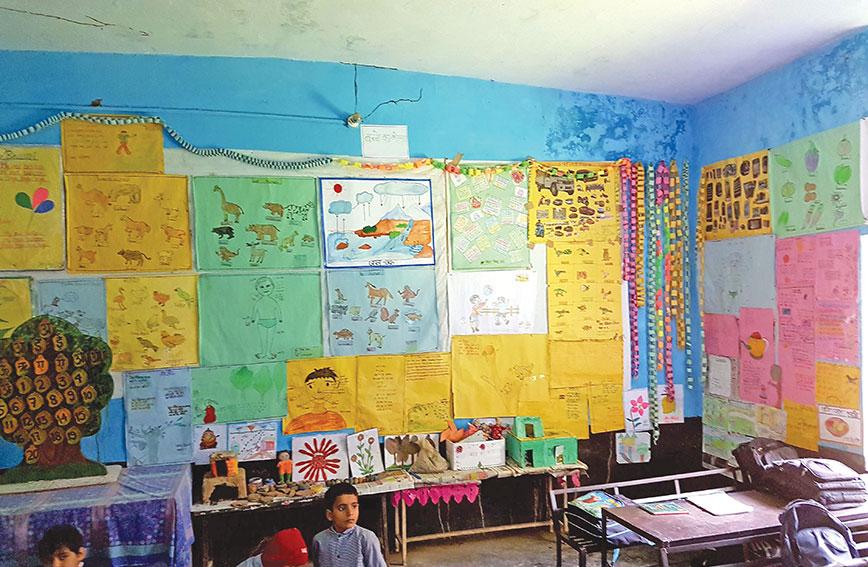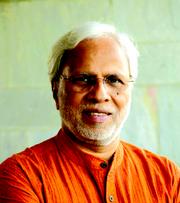

DILEEP RANJEKAR
It takes around 90 minutes for us to reach the government school, about 65 km from Dehradun. The school is in a jungle and primarily caters to the children of the tribal community in the region. It is a two-room school managed by a head teacher (who also teaches) and another teacher, who teaches children in five grades. As we find in many such government schools, both the head teacher and the teacher are diligently trying to do meaningful work in the school. The classrooms are full of teaching- learning material prepared by the children and are very relevant to what they need to be learning.
While the head teacher is quite cooperative, the person who stands out is the young lady teacher who is completely immersed in her role. She lives about 30 km from the school and reaches it by public transport about half an hour before classes begin. This requires her to wake up at 5 am each day and complete household chores before leaving home.
The teacher very enthusiastically greets us and explains various teaching-learning practices that she follows. She proudly shows us the individual files she has personally built for every child, which includes their history since joining the school, their family background and their progress in learning. It is truly impressive since it has helped her so much to deal with every child with greater understanding and depth. Everything is so neatly documented. She also gives very interesting projects to groups of children that she has evolved by observing the children.
We are inside the classroom for almost 45 minutes. Not a single child looks at us, nor do they come up to her to ask for anything. They are completely focussed on the activities they are doing in groups. It is like a classroom on auto-pilot, smoothly sailing on pre-set norms. The teacher tries to give credit for all this to her recent association with the teacher learning centre of the Azim Premji Foundation. However, we know that she is a different teacher. While the discussions and events at the teacher learning centre might have helped her by shaping her ideas better, in essence she is a creative teacher who has a mind of her own. More important, she has the ability to think and interpret education in her own manner.
Imagine the enormous job the teacher has to perform while minding 30 to 40 children in a classroom — day in and day out. Many young mothers have shared with me how exhausting the job of looking after just one or two children is. Children come from different family backgrounds, different socio-economic strata, different abilities, different health levels and different aspirations. In a rural government school, most children, when they enter Class I, have no exposure to education at all since they have no experience of early childhood education — unlike their urban counterparts who often go through two to three years of nursery / kindergarten exposure in some manner or the other. Most children have no parental support in their education preparation since their parents are either illiterate or first generation literates — or are fully occupied with livelihood issues.
The National Curriculum Framework speaks of attention to the individual child, helping every child realise his or her potential and also the child being at the centre of the educational process. The teacher is expected to be responsible for implementation of various government programmes and schemes. She is expected to be part of the midday meal programme arrangements each day. She is also expected to deal with the parents and the members of the School Management Committee. In effect, she is expected to be like Goddess Durga with 10 hands and multiple weapons in her hands.
In practically all formal ceremonies the role of the teacher (guru) in society is eulogised as the one next to that of the mother. And yet, in most conversations about school education, the teachers are often the butt of all the criticism. They serve as the favourite punching bag for one and all. Even well-educated people loosely blame teachers for today’s quality of education. References are made to teacher absenteeism without recognising the absenteeism that prevails in all government departments.
And what do we do to enable and support the teacher before or after she becomes a teacher?
Given the poor quality of graduation, we expect a person to become a teacher through a 10-month B.Ed. programme (recently extended to two years). A programme that is delivered in non-multi-disciplinary institutions run by people who have nothing much to do with education; with a curriculum that is outdated and does not aim to prepare the teacher to successfully meet the enormity of the challenge in the classroom. A curriculum and a process that does not prepare the teacher to deal with the multigrade situation that prevails in more than 75 percent of our schools. A curriculum that at best provides only lip service to concepts such as “constructivism”. A programme that is managed by poor quality faculty members. A programme where the assessment of the teacher is not rigorously made.
The selection of teachers happens by and large merely by ranking teachers who pass their B.Ed. courses in the institutions described above. There are no additional criteria used to select teachers. In certain states, the selection process is highly politically influenced. The selection of teachers is not followed by a high-class induction or assimilation programme.
During the service, hardly anything is done to motivate the teacher or enable her to deal with the humungous responsibility of nation-building. Most states had a budget of a paltry `500 per teacher per year. That too was not actually spent by the teachers due to the fear of audit of their expenses. In certain states, during the past five years, this budget has been discontinued. The in-service training of teachers is designed centrally and delivered by poor quality teacher educators. Most institutions that have been created at state, district, block and cluster level do not have people of necessary quality as well as of required number. The budgets provided for the in-service teachers are not sufficient to carry out programmes of superior quality.
Despite all these challenges, there are teachers who take charge of their all-important role and devise strategies that are innovative and useful for the realisation of the potential of the children. We need to have systems in place that would encourage and motivate more and more teachers to build the perspective of their important role in nation-building. Of the eight million teachers we have, about 20 percent are competent and self-motivated. That makes a whopping number of 16 lakh teachers. We need to take steps to progressively increase this number to over 75 percent! This would go a long way in delivering education of the quality aimed at in the education policy and moving towards the society envisaged in our Constitution.
Dileep Ranjekar is CEO of the Azim Premji Foundation
Comments
Currently there are no Comments. Be first to write a comment!



